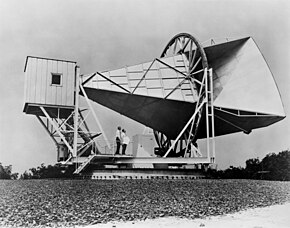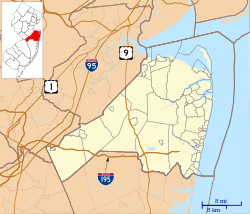
Back Antenna a tromba di Holmdel Italian Рупорно-параболическая антенна в Холмдейле Russian Голмдельська рупорна антена Ukrainian
 The Holmdel Horn Antenna in use in 1962 | |
| Named after | Holmdel Township |
|---|---|
| Location(s) | Holmdel Township, Monmouth County, New Jersey |
| Coordinates | 40°23′27″N 74°11′05″W / 40.39072°N 74.18483°W |
| First light | 1959 |
| Telescope style | cosmic microwave background experiment horn antenna radio telescope |
| Diameter | 20 ft (6.1 m) |
Holmdel Horn Antenna | |
| Built | 1959 |
| Architect | A.B. Crawford[1] |
| NRHP reference No. | 89002457 |
| Significant dates | |
| Added to NRHP | December 20, 1989[2] |
| Designated NHL | December 20, 1989[3][4] |
| | |
The Holmdel Horn Antenna is a large microwave horn antenna that was used as a satellite communication antenna and radio telescope during the 1960s at the Bell Telephone Laboratories facility located on Crawford Hill in Holmdel Township, New Jersey, United States.[5] It was designated a National Historic Landmark in 1989 because of its association with the research work of two radio astronomers, Arno Penzias and Robert Wilson.[1]
In 1965, while using this antenna, Penzias and Wilson discovered the cosmic microwave background radiation (CMBR) that permeates the universe.[6] This was one of the most important discoveries in physical cosmology since Edwin Hubble demonstrated in the 1920s that the universe was expanding. It provided the evidence that confirmed George Gamow's and Georges Lemaître's "Big Bang" theory of the creation of the universe. This helped change the science of cosmology, the study of the universe's history, from a field for unlimited theoretical speculation into a discipline of direct observation. In 1978 Penzias and Wilson received the Nobel Prize for Physics for their discovery.[7]
- ^ a b Butowsky, Harry (May 1, 1989). "Holmdel Horn Antenna". National Register of Historic Places Inventory-Nomination. National Park Service.
- ^ "National Register Information System". National Register of Historic Places. National Park Service. January 23, 2007.
- ^ "NJ NHL list" (PDF).
- ^ "Holmdel Horn Antenna". National Historic Landmark summary listing. National Park Service. June 23, 2008. Archived from the original on February 25, 2009.
- ^ Cite error: The named reference
Crawfordwas invoked but never defined (see the help page). - ^ Penzias, A. A.; Wilson, R. W. (July 1965). "A Measurement of Excess Antenna Temperature at 4080 Mc/s". Astrophysical Journal. 142. American Astronomical Society: 419–421. Bibcode:1965ApJ...142..419P. doi:10.1086/148307.
- ^ Chown, Marcus (September 29, 1988). "A Cosmic Relic in Three Degrees". New Scientist. pp. 51–52.



